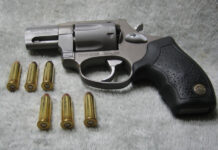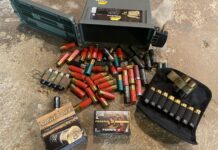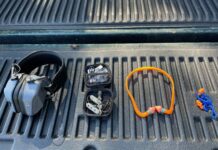Who doesn’t love Predator? Two juiced up governors-to-be on screen simultaneously throwing lead at a common enemy and taking out bad guys. Its a typical late-80s action film, but the reason that it always stuck in my mind was Governor Ventura’s handheld M134 minigun. Nevermind that (if real) the weapon would only have enough ammunition for less than 5 seconds of firing, I thought it was a great concept. Apparently an Iowa National Guard unit (1st Battalion, 133rd Infantry Regiment, 2nd Brigade Combat Team, 34th Infantry Division, Iowa National Guard) thought so too, and that’s why they built one.
Well, not the whole thing — the minigun is impractical. The ammunition backpack, on the other hand, is genius.
From the Army news website…
“When we first arrived in theater in late October (2010), we were issued the Mk 48 7.62 mm machine guns,” Winkowski said. “This was a new piece of equipment for us, and we struggled to come up with a solution for carrying and employing ammunition for it due to our small size and the inability to have a designated ammo bearer, as is common doctrine with the M240B.
“The ammunition sacks that came with it made it too cumbersome and heavy to carry over long, dismounted patrols and especially when climbing mountains. Initially, we came up with using 50-round belts and just reloading constantly, which led to lulls of fire and inefficiency.”
The same issue has plagued machine gunners since the dawn of full auto fire. The MG crews of WWI used five soldiers just to manhandle a single machine gun around the battlefield — one gunner, one loader, and three minions to carry the ammo (and other gubbins). Larger units had enough manpower to let the machine gunner have a mule for his bullets, but this National Guard unit had to make do with their small numbers. That led Staff Sgt. Vincent Winkowski to come up with a genius solution.
[…] Winkowski grabbed an old ALICE (all-purpose lightweight individual carrying equipment) frame, welded two ammunition cans together — one atop the other after cutting the bottom out of the top can — and strapped the fused cans to the frame. To that he added a MOLLE (modular, lightweight load-carrying equipment) pouch to carry other equipment.
“We wondered why there wasn’t some type of dismounted (Common Remote Operating Weapons Station) that fed our machine guns instead of a mini-gun as portrayed in the movie,” Winkowski said. “So, I decided to try it using the feed chute assembly off of the vehicle CROWS. We glued a piece of wood from an ammo crate inside the ammo cans to create the decreased space necessary so the rounds would not fall in on each other.
Just days after they welded the thing together it had its first trial by fire, as the small unit came under fire from 50 enemy combatants. And performed perfectly.
A short while later the unit submitted their invention to the Army’s Research and Development wing. Their first reaction? And I qoute: “Wow, that’s cool.” And then they went and improved it a little.
The folks at NSRDEC substituted a MOLLE medium frame for the ALICE frame. The ammo compartment now uses polycarbonate plastic instead of the original tin. Until NSRDEC can come up with a simpler, more cost-effective substitute, the ammo will continue to move through a 27-inch-long, $1,710 feed chute designed for the CROWS, which the Guardsmen had employed.
Word of the backpack has spread through units deployed in theater, and copycat backpacks are starting to pop up and be used in multiple units.
“We’ve already gotten email traffic from (one of) our science advisers that everybody in theater wants one of these — and by in theater, he means his specific area of operation, Regional Command East in Afghanistan — because word has spread,” Roy said. “That (Iowa National Guard) unit is not the only unit on that FOB. As they’re walking around the FOB with that piece of kit, very senior people are taking a look at it. They recognize it as a game-changer.”
The R&D department hopes to have a polished and finalized design ready for full production and deployment by early 2012. This hacked together backpack, inspired by an 80s movie and designed by a rag-tag National Guard unit, represents a leap forward in the capabilities of machine gunners on the battlefield and might just be a “game changer” for our troops overseas.
UPDATE: It seems that a similar system has been available for years, from TYR Tactical. For $4k. So instead of being a story about Army being forward thinking, this seems to be a story about how the Army spent thousands of dollars re-inventing the wheel. Very nice. (Thanks to GA Koenig for bringing it up.)
All pictures (C) U.S. Government.








as a COD fan boy ill say this
“too cool”
Necessity is the mother of invention and inspiration can come from anywhere at any time. There is again proof that in our armed forces are some of the most brilliant, creative and inventive men and women ever.
Unfortunately, our enemies come close to matching all of those traits. Japanese tactics to draw our guys out in the open in WWII, VC tunnels and clever trailside traps and ambushes in Vietnam; ever-improving IEDs in Iraq and Afghanistan.
It gladdens my heart to see stuff like this, but it isn’t exclusively American.
Proof that American Ingenuity is alive and well.
This will be on the history channel in 50 years.
Lovely story. Unfortunately, it is bullshit.
KitUp and SoldierSystems blogs both pointed out that Natick (the place where the Army does their own gear development) basically wasted a whole mess load of time and resources developing something that was already a proven product. Tyr Tactical has had their Machine Gunners Assault Pack on the market for over two years… and the Army has already procured a bunch of them for testing and deployment.
http://www.tyrtactical.com/products/details/backpacks/mico-light-and-heavy-machine-gunners-assault-pack/
Essentially, what happened is that some Iowa National Guard soldiers saw the Tyr backpack, couldn’t find it in the national stock system, so they rigged one of their own. Program Office: Soldier Systems (the tendril of the Army responsible for gear) saw this, deployed their neato sounding Cell and re-created the thing in a more professional/manufacturable form.
Problem though; the Army was already aware of the TYR Tactical Machine Gunners Assault Pack… they had bought a few of them already and evaluated them as working pretty well. They just never bothered to go beyond that and either field it or make it available to units who felt it would be helpful.
So really, while the folks in the Army want this to look like a big win (“Look at how fast we are at meeting our soldier’s needs!”), the reality is that this whole situation shows just what a failure the Army is. They spent taxpayer money developing something that they could have just bought from a company that had already invested in creating the design.
To many folks who design military gear, this sort of thing happens all too often.
I’m with you, sort of. Tyr charges $4000 for their pack. While we would have to assume that a bulk order from the US government would earn a substantially lower price, it is still likely that a unit with a design owned by Uncle Sam could be made and purchased at a much lower cost. Once someone develops a feed chute that can be manufactured more cheaply, they’ll be golden. And the company that first recognized the need, and spent the time and money to develop a useful solution, may be out of the running for a lucrative contract.
The Army had a horrid record of developing products in-house. While the per-unit acquisition costs of an in-house, Army developed product might look appealing, there are many hidden downsides:
– Overall product reliability is often lower than commercially produced goods.
– Army R&D tends to be bloated and extremely expensive. When amortized across the entire purchase and added to the acquisition costs, you usually would have been better off going off-the-shelf.
– Speed of Army product development is often glacial. They might have whipped out a few prototypes in 48 days, but it will take them 3 years to get to series production once their super cool “cell” of designers hands the project off to the chair moisteners for production ramp.
Frankly, it also comes down to the fact that the Army doesn’t hire talent. Folks who can engineer outdoor stuff well or design flossy kit don’t go work for the Army. They go work for Arc’Teryx, Nike, Columbia, Addidas or (in the military world) Cray or a few companies who fly under the radar making the REALLY cool kit we never get to see (like Wilcox).
Bottom line: the Army, deployed soldiers and taxpayers would all have been better off had someone at Natick just whipped out their GSA card and gone to TYR in the first place.
As innovating as Sergeant Curtis Culin’s “bocage buster” fitted to Sherman tanks in Normandy.
Not quite the feel good PR story the Army wants taxpayers and legislators to believe it is…
Fun fact: A 7.62×51 NATO cartridge weighs nearly an ounce. An M134 minigun has a cyclic rate of 2000-6000 rpm. For five seconds of sustained fire, in real life, Jesse Ventura would needed to carry more than his weight in ammo.
(In the movie, the rate of fire was lowered to 1250 rpm, and he was of course using blanks. Still a heavy pack. Perhaps this is why miniguns have yet to replace LMGs.)
Minnie Gun requires a electric power source
That pack is a great idea. I’ve always wondered why the army didn’t have one for MGers. TYR’s pack is cool, but 4k? Even more surprising is that feed chute alone is 2k? What’s it made of? Titanium and carbon fiber?
The military services have had the pack system for years…Hollywood didn’t come up with the idea for the movie. It was given to them by……….
Watch the movie
What’s that? Oh… Just another wheel.
http://www.youtube.com/watch?v=iTeMU61qKGY
4:52
What’s up with the military and it’s acronyms? CROWS, MOLLE, ALICE? I think they’re all FUBAR.
A better question would be, “does this innovation turn the user into a sexual tyrannosaurus?”
No, but Copenhagen Long Cut certainly will.
So much for the Rapid Fielding Initiative (RFI). It was put in place so Soldiers could ID a piece of civilian manufactured equipment that would serve the military well and get it into the supply system quicker. Guess the NG went to the wrong folks.
Its fair to criticize military R&D for taking too long and spending too much, but in the last 40 years out privatized defense industry hasnt had a much better record. There are occasional successes, but our unlimited Star Wars budgets and ‘cost plus’ no-bid contracts have pissed away trillions of dollars for minimal gain.
The entire fleet of half-billion dollar F22s was grounded for five months, as one typical example. And the F35 isn’t doing much better.
So..Tyr sells these things for $4k.
Some soldiers cobbled together a useable version in the field out of two ammo cans, bits of wood, some stuff taken from a vehicle and a common backpack.
Does also make $400 toilet seats?
So where’s Jesse Ventura’s power source for his M134?
Joe Normal says: October 24, 2011 at 13:43 So where’s Jesse Ventura’s power source for his M134?
Very good question Joe:
The M134 is an electrically driven, mechanically fired air cooled system, meaning it requires an electrical power source to cycle the weapon by a battery or direct AC/DC ’power source.
There are power source systems that are stand alone battery power.
Jesse Ventura would have had to be carrying a battery and power cord.
There is a great deal of torque induced to the gun due to the high rate of barrel rotation and there is also a heavy deflection to the muzzle flash structure due to the fired barrels gas exhaust striking the shield.
Warning: The gun can be fired by manually by rotating the barrel cluster, which did lead to a fatal self induce gunshot wound to the face of a “gun expert” at a gun show in PA.
Douglas H Wolcott
TACOM Weapons LAR
Comments are closed.